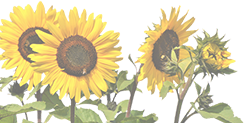
How to Grow a Thriving Butterfly Garden
By Chris Edmunds

Who doesn't love watching a beautiful butterfly flit around your yard, pausing to sip nectar from your flowers? Butterflies are also an essential pollinator, and their presence indicates a healthy, stable habitat. Unfortunately, butterfly populations across the states are in decline due to habitat loss and widespread usage of pesticides. We can support butterflies by providing them with safe habitats in our own gardens.
Creating a welcoming space for butterflies isn't difficult. There are lots of choices for plants, shrubs, and trees that butterflies absolutely love. Adding a few of these will go a long way to attracting butterflies to your garden.
 Feed the Butterflies
Feed the Butterflies
Milkweed is a classic favorite for many types of butterflies. There are a few different varieties of milkweed you can get for your garden. Milkweed will attract Monarchs, Great Spangled Fritillaries, and Eastern Tiger Swallowtails.
Other flowers and plants that will attract butterflies are violets, verbena, petunias, bergamot, purple coneflower, lotus, lupines, sweet clover, Shasta daisies, salvia, lantana, alyssum, aster, bee balm, calendula, cosmos, lilies, dianthus, marigolds, nasturtiums, phlox, yarrow, lavender, portulaca, and zinnias.
Some shrubs and trees that butterflies like are almond, apple, blackcurrant, butterfly bush, cherry, gooseberry, hawthorn, linden, locust, pear, plum, raspberry, strawberry, wild lilac, willow.
Growing native wildflowers is also a great way to support local species of pollinators, not just butterflies. In the springtime, you can pick up a seed mix for local wildflowers at one of our seasonal locations.
When you are selecting plants for butterflies, avoid choosing hybrid varieties. Often hybrids don't have a strong scent and don't produce nectar, so while they might look nice, but they won't help out your local butterflies.
 Help Them Feel At Home
Help Them Feel At Home
Butterflies also need a few other things to flourish. They must have access to shelter from wind and rain in your yard. In addition to flowering plants, they need plants that provide their larvae, otherwise known as caterpillars, with the food sources they need to grow and develop into butterflies.
Excellent plants for hosting larvae are borage, fennel, grasses, hollyhocks, lupine, milkweed, nettles, thistles, willow.
Butterflies also require water and minerals. You'll often see butterflies resting on bare soil around puddles after a rain. The damp earth allows them to extract the minerals they need from the soil. Providing them with a shallow dish of water sunk into the soil will let them drink safely and get the minerals they need. Fill a shallow dish with marbles or pebbles so they can stay dry while they drink.
 The Key to Supporting Butterfly Populations
The Key to Supporting Butterfly Populations
One of the biggest dangers to butterfly populations is the use of pesticides. If you can, avoid using chemical pesticides in your yard, as they will kill butterflies in addition to the pests you're trying to target. There are plenty of natural solutions for dealing with pests, so your yard can be a safe haven for pollinators.
Visit one of our locations during the growing season to add some butterfly-friendly plants to your garden! We can help you pick out options that will fit perfectly with your existing garden design.

